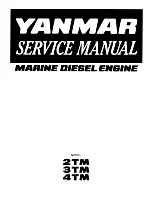
PRODUCT INFORMATION
INDEX
DATE
Dep.2
IO-C-M-45-001e B
June 2008
MAINTENANCE OF TURBOCHARGER
3/4
3. CLEANING THE TURBOCHARGER
Dust particles entering the intake air pipe may cause damage to the compressor of the supercharging system.
Bearing in mind that even the most efficient air filter allows a small amount of dirt to pass through, dirt will adhere
to the compressor blades if there is oil or similar substances on them.
This will unbalance the blades and reduce the efficiency of the turbo. Therefore, it is advisable to set up a
compressor cleaning plan based on the operating conditions and to remove periodically any dirt particles
adhering to the blade surface. To eliminate dirt, avoid inadequate methods like scraping with a screwdriver,
sandpaper, emery cloth or steel wool.
To clean the turbocharger effectively, proceed as follows:
-
Disassemble the turbocharger following the instructions in its maintenance manual. The parts to be
cleaned are: the compressor housing, the turbine casing, the shaft with compressor wheel, turbine
runner, central bearing body, and the turbine plate.
-
Dip the components in a container with a solvent (e.g. trichloroethylene) until they are free from grease or
oil residues. Neutral household soap can be used instead of solvent, provided it has no chemical effect
on the components.
-
Dry the components thoroughly with compressed air. There should be no traces of solvent on the parts.
-
Remove any dirt or scale left with a non-metallic brush or plastic scraper. Next, dip the components again
into the solvent.
-
After cleaning the components, apply clean motor oil to the friction areas: shaft and bearing body.
ATTENTION
Handle the turbocharger components with great care while cleaning and drying them to avoid any
damage.
4. TURBOCHARGER FAILURE ANALYSIS
Due to high pressure and high temperature working conditions, the turbocharger wheels are made very sensitive
to abrasive and other specific operating environments.
Some of the most frequent causes of turbocharger failure include:
Presence of foreign material in the intake system
, causing damage to the compressor blade profile. Foreign
materials can be of such nature as:
- Weld slag that failed to be removed from the pipes.
- Particles that detach from air filters.
- Nuts, bolts, washers, etc.
- Compressor wheel fixing nut loose and moving along the threaded shaft.
-
…
5.2.63
O&M_2.002211.810_A_10_2016
















































